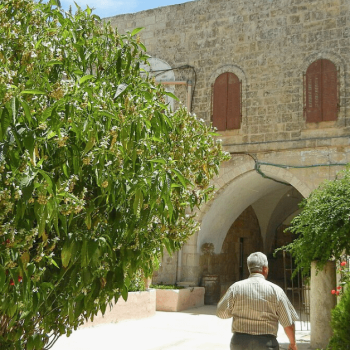Note: This article is part of a special Patheos Symposium, Passing on the Faith: Teaching the Next Generation. Read more perspectives here.
An elderly man stricken with Alzheimer's is no longer able to form a coherent sentence, but when he hears a familiar hymn he smiles and perfectly sings along—his mind no longer able to retain meaning, yet still he is held by grace.
At a nearby university, in order to study early parent-child relationships, researchers are observing a video of a Chinese mother cooing to her baby; unexpectedly, graduate students under stress repeatedly come to secretly sit in the back row and indulge in the healing coos.
Beneath layers of language, concept, and custom, there lies a radical human openness to aesthetic encounter, to beauty. Harvard aestheticist, Elaine Scarry, observes that when we meet beauty we experience a surfeit of aliveness, a "wake up call" to the plenitude of life. "Beauty quickens. It adrenalizes. It makes the heart beat faster. It makes life more vivid, animated, living, worth living." Further, "Beauty establishes a contract or covenant between the perceiver and the beautiful object, compelling the perceiver to carefully attend to and protect the "aliveness" of the beautiful object."
According to mystical theologian Simone Weil, beauty requires us to "...give up our imaginary position at the center of the world. A transformation takes place at the very roots of our sensibility, in our immediate reception of sense impressions and psychological impressions." We are absorbed into the world, enjoining the community of beauty. British novelist Iris Murdoch tells of a day when she was anxious, resentful, and brooding, but upon seeing a beautiful kestrel flying above her, all of this fell away. All of the energy formerly in the service of protecting, guarding, and advancing the self is now free to be in the service of something else. This is an important prelude to justice and truth.
Beauty also has a clear outward pulse. "Wittgenstein says that when the eye sees something beautiful, the hand wants to draw it." Beauty brings copies of itself into being. It makes us draw it, take photographs of it, or describe it to other people. Sometimes beauty is replicated exactly, other times it inspires more creative events. Beauty also crosses modes, such as when the fair cheek of a child prompts a caress, or inspires us to play with or care for the child. This crisscrossing of senses happens in all directions, prompting Augustine to think of God when he touches something smooth and pleasant, or the beauty of Beatrice prompts Dante to write The Divine Comedy.
Beauty also evokes in us an impulse to community. Art galleries and museums are filled with people who come to share beauty; and among the most common responses is a postcard or phone call seeking connection, such as "Washington is filled with cherry blossoms; I wish you were here! Come as soon as you can."
In the modern era, Christian formation based its practices on learning theories concerned with the True (cognitive theories—how to cultivate ideas) and the Good (ethical theories—how to cultivate justice), but, with few exceptions, ignored their sibling Beauty, without which the other two are inert. The choice of beauty as a principle of formation is not merely a technical matter, but is a deeply theological issue. God did not only create all things, but weighted them (kavod) with God's own glory (Gen. 1:27), which is often translated as beauty. The Bible reveals the culmination of all things not as endless discussion of ideas or doing good, but as an aesthetic vision of eternal praise (Rev. 5:13). Not only is beauty protologically and eschatologically confirmed, but Jesus Christ is revealed in John's gospel as the image or "art" of God (Jn. 1:1-18). These aesthetic themes were prominent until modernity reduced beauty to a bourgeois ornament.
Rightly understood beauty constitutes a call to attend to the very Object of Christian faith—the glory of God. If, as confirmed by theologians from Gregory Nyssa to Karl Barth, the sine qua non of God is beauty, then it stands as an unfulfilled mandate for the Church to participate in God's eternal ecology of Beauty. By this we do not mean mere "prettiness," but the wonder of God's donation made manifest in creation, especially God's self-donation in Jesus Christ. In beauty, we do not "comprehend" God; instead beauty stands as an invitation into God's mystery. Beauty cannot be subjected to our will; we are subject to beauty.
If beauty is the Church's principle way of knowing, then education and formation cannot simply be reduced to enumerating concepts, lists, and doctrines—or as Balthasar said, "a kind of butterfly collection for the mind"—but we will "reclaim in it our sense of Beauty, our spiritual senses that grasp the colors and the contours, the taste and the fragrance of Truth in its radiant body." Formation requires our creativity to express and respond to the glory of God in appropriate ways—in song, art, poetry, and story, in liturgy, and in how we organize communities of peace. But first, we must learn again with the eyes of children, awake to a world laden with God's wondrous beauty.
8/12/2013 4:00:00 AM




